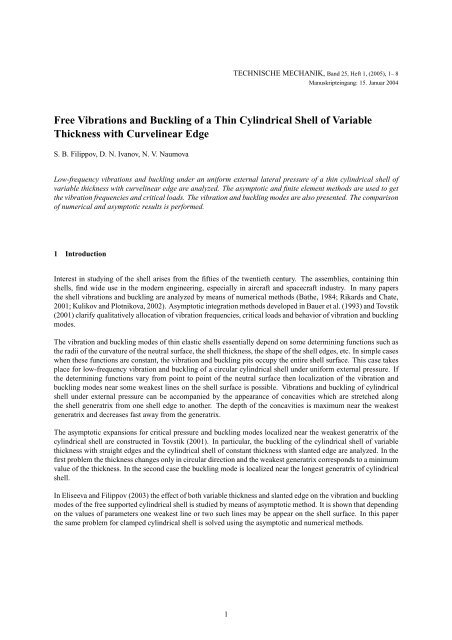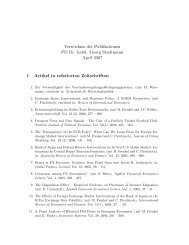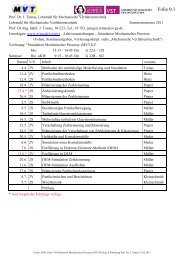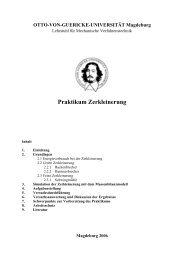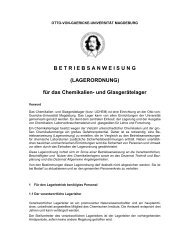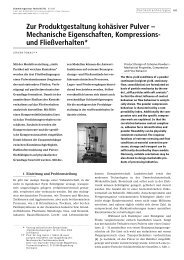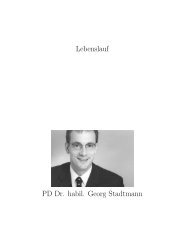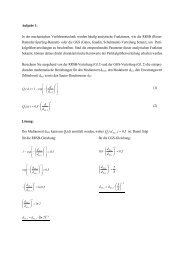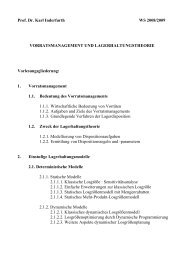Free Vibrations and Buckling of a Thin Cylindrical Shell of Variable ...
Free Vibrations and Buckling of a Thin Cylindrical Shell of Variable ...
Free Vibrations and Buckling of a Thin Cylindrical Shell of Variable ...
You also want an ePaper? Increase the reach of your titles
YUMPU automatically turns print PDFs into web optimized ePapers that Google loves.
TECHNISCHE MECHANIK, B<strong>and</strong> 25, Heft 1, (2005), 1– 8Manuskripteingang: 15. Januar 2004<strong>Free</strong> <strong>Vibrations</strong> <strong>and</strong> <strong>Buckling</strong> <strong>of</strong> a <strong>Thin</strong> <strong>Cylindrical</strong> <strong>Shell</strong> <strong>of</strong> <strong>Variable</strong>Thickness with Curvelinear EdgeS. B. Filippov, D. N. Ivanov, N. V. NaumovaLow-frequency vibrations <strong>and</strong> buckling under an uniform external lateral pressure <strong>of</strong> a thin cylindrical shell <strong>of</strong>variable thickness with curvelinear edge are analyzed. The asymptotic <strong>and</strong> finite element methods are used to getthe vibration frequencies <strong>and</strong> critical loads. The vibration <strong>and</strong> buckling modes are also presented. The comparison<strong>of</strong> numerical <strong>and</strong> asymptotic results is performed.1 IntroductionInterest in studying <strong>of</strong> the shell arises from the fifties <strong>of</strong> the twentieth century. The assemblies, containing thinshells, find wide use in the modern engineering, especially in aircraft <strong>and</strong> spacecraft industry. In many papersthe shell vibrations <strong>and</strong> buckling are analyzed by means <strong>of</strong> numerical methods (Bathe, 1984; Rikards <strong>and</strong> Chate,2001; Kulikov <strong>and</strong> Plotnikova, 2002). Asymptotic integration methods developed in Bauer et al. (1993) <strong>and</strong> Tovstik(2001) clarify qualitatively allocation <strong>of</strong> vibration frequencies, critical loads <strong>and</strong> behavior <strong>of</strong> vibration <strong>and</strong> bucklingmodes.The vibration <strong>and</strong> buckling modes <strong>of</strong> thin elastic shells essentially depend on some determining functions such asthe radii <strong>of</strong> the curvature <strong>of</strong> the neutral surface, the shell thickness, the shape <strong>of</strong> the shell edges, etc. In simple caseswhen these functions are constant, the vibration <strong>and</strong> buckling pits occupy the entire shell surface. This case takesplace for low-frequency vibration <strong>and</strong> buckling <strong>of</strong> a circular cylindrical shell under uniform external pressure. Ifthe determining functions vary from point to point <strong>of</strong> the neutral surface then localization <strong>of</strong> the vibration <strong>and</strong>buckling modes near some weakest lines on the shell surface is possible. <strong>Vibrations</strong> <strong>and</strong> buckling <strong>of</strong> cylindricalshell under external pressure can be accompanied by the appearance <strong>of</strong> concavities which are stretched alongthe shell generatrix from one shell edge to another. The depth <strong>of</strong> the concavities is maximum near the weakestgeneratrix <strong>and</strong> decreases fast away from the generatrix.The asymptotic expansions for critical pressure <strong>and</strong> buckling modes localized near the weakest generatrix <strong>of</strong> thecylindrical shell are constructed in Tovstik (2001). In particular, the buckling <strong>of</strong> the cylindrical shell <strong>of</strong> variablethickness with straight edges <strong>and</strong> the cylindrical shell <strong>of</strong> constant thickness with slanted edge are analyzed. In thefirst problem the thickness changes only in circular direction <strong>and</strong> the weakest generatrix corresponds to a minimumvalue <strong>of</strong> the thickness. In the second case the buckling mode is localized near the longest generatrix <strong>of</strong> cylindricalshell.In Eliseeva <strong>and</strong> Filippov (2003) the effect <strong>of</strong> both variable thickness <strong>and</strong> slanted edge on the vibration <strong>and</strong> bucklingmodes <strong>of</strong> the free supported cylindrical shell is studied by means <strong>of</strong> asymptotic method. It is shown that dependingon the values <strong>of</strong> parameters one weakest line or two such lines may be appear on the shell surface. In this paperthe same problem for clamped cylindrical shell is solved using the asymptotic <strong>and</strong> numerical methods.1
2 Basic EquationsWe take the radius, R, <strong>of</strong> the cylindrical shell as unit <strong>of</strong> measurement <strong>and</strong> introduce on the middle surface <strong>of</strong> theshell the orthogonal dimensionless coordinate system (s, ϕ):s ∈ [0, l(ϕ)]ϕ ∈ (−π, π],where l(ϕ) is the length <strong>of</strong> the shell generatrix. The shell edge s = 0 is straight <strong>and</strong> the edge s = l(ϕ) iscurvelinear.If l(ϕ) = l c − tg β cos ϕ then the edge s = l(ϕ) is slanted by the angle β. In case β = 0 the both shell edges arestraight. In Figure 1 are shown two cross-sections <strong>of</strong> the cylindrical shell with slanted edge.Figure 1. <strong>Cylindrical</strong> shell with slanted edge.We suppose that dimensionless shell thickness h is small <strong>and</strong> depends on the coordinate ϕ:where h 0 is a small parameter, g ∼ 1.h(ϕ) = h 0 g(ϕ)In particular, for the cylindrical shell which cross-section is obtained by the cutaway the circle <strong>of</strong> the radius r fromthe circle <strong>of</strong> the radius R = 1 (see Figure 1) function g(ϕ) <strong>and</strong> parameter h 0 have the following formg(ϕ) = 1 + γ(1 − cos ϕ) h 0 = h(0) = 1 − r − e γ = e/h 0 (1)where e is the distance between the circles centers. In case e = 0 the shell has the constant thickness h 0 . Ingeneral case h 0 = h(0) is the least value <strong>of</strong> h(ϕ) whereas h m = h(π) = 1 − r + e is the maximum <strong>of</strong> h(ϕ). Thedependence <strong>of</strong> the thickness ratio η = h m /h 0 on γ has the form η = 1 + 2γ.The dimensionless equations describing the small free vibrations <strong>and</strong> buckling <strong>of</strong> a thin elastic cylindrical shell(see Eliseeva <strong>and</strong> Filippov (2003)), can be written asε 4 ∆(g 3 ∆w) − ∂2 Φ∂s 2 + λZ = 0ε4 ∆(g −1 ∆Φ) + ∂2 w∂s 2 = 0 (2)Here w(s, ϕ) is the normal deflection, Φ(s, ϕ) is the force function,∆ = ∂2∂s 2 + ∂2∂ϕ 2 ε 8 h 2 0=12(1 − ν 2 )ν is Poisson’s ratio. In case <strong>of</strong> the buckling under an uniform external lateral pressure pZ = ε 2 ∂2 w∂ϕ 2 λ = pEh 0 ε 6 ,where E is Young’s modulus. For the problem <strong>of</strong> the shell vibrationswhere ω is the vibration frequency, ρ is the mass density.Z = −gw λ = ρR2 ω 2ε 4 E ,To find the parameter λ we have to take into account the boundary conditions on the shell edges s = 0 <strong>and</strong>s = l(ϕ).2
3 Asymptotic AnalysisAccording to a procedure proposed by Tovstik (2001), the asymptotic solution <strong>of</strong> the boundary value problem forequations (2), can be expressed as( ∫ i ϕ)∑ ∞w(s, ϕ, ε) = exp q(ϕ) dϕ ε k w k (s, ϕ) λ =ε ϕ 0 k=0∞∑ε k λ k (3)k=0whereIm q(ϕ 0 ) = 0{ } dqImdϕ (ϕ 0) > 0 (4)Function Φ has similar asymptotic expansion. It follows from conditions (4) that the functions w <strong>and</strong> Φ arelocalized near the line ϕ = ϕ 0 . By substituting expressions (3) into (2) <strong>and</strong> boundary conditions we get theequations for q(ϕ), w k (s, ϕ), Φ k (s, ϕ) <strong>and</strong> λ k . In the zeroth-order approximation we obtaind 2 Φ 0ds 2 − q4 g 3 w 0 + λ 0 Nw 0 = 0d 2 w 0ds 2+ q4g Φ 0 = 0 (5)where N = q 2 for the buckling problem, N = g for the vibration one. The elimination <strong>of</strong> the function Φ 0 fromsystem (5) gives the following equationd 4 w 0ds 4 − α4 w 0 = 0 α 4 q 4 N= λ 0 − g 2 q 8 (6)gWe suppose that the shell edges are clamped. Then the boundary conditions for equation (6) arew 0 = dw 0ds= 0 s = 0 s = l(ϕ) (7)The asymptotic solution in case <strong>of</strong> freely supported shell edges is analyzed in Eliseeva <strong>and</strong> Filippov (2003). Thechoice <strong>of</strong> boundary conditions for equation (6) is discussed in Tovstik (2001).The solutions <strong>of</strong> boundary value problem (6), (7) have the formw 0n = U(α n s)T (α n l) − T (α n s)U(α n l) n = 1, 2, . . .where<strong>and</strong> α n is a root <strong>of</strong> the equationT (z) = sinh z − sin zU(z) = cosh z − cos zcosh(αl) cos(αl) = 1 (8)The values <strong>of</strong> α n depend on the boundary conditions. If the shell edges are freely supported then α n = πn/l.Taking into account second formula (6) we get that λ 0 is the function <strong>of</strong> the parameters q <strong>and</strong> ϕ:λ 0 = f(q, ϕ) = α4 gq 4 N + q4 g 3N . (9)As the zeroth-order approximation for the eigenvalue λ we selectThenλ 0 = minq,ϕ f(q, ϕ) = f(q 0, ϕ 0 ) (10)λ q = ∂f∂q = 0λ ϕ = ∂f∂ϕ = 0 for q = q 0 ϕ = ϕ 0 (11)3
The root ϕ 0 <strong>of</strong> equation (15) corresponds to the weakest generatrix ifΛ 1 = 2A(ϕ 0 ) cos ϕ 0 + 15γ 2 sin 2 ϕ 0 /g 2 (ϕ 0 ) > 0It is easy seen that for γ < γ 1 exists only one weakest generatrix ϕ = π, for γ 1 < γ < γ 2 we have two weakestlines ϕ = ±ϕ ∗ <strong>and</strong> in case γ > γ 2 on the shell is again only one weakest generatrix ϕ = 0. The location <strong>of</strong>weakest lines does not depend on the boundary conditions.Assume that the parameters l c <strong>and</strong> β > 0 are fixed whereas the thickness ratio η = h m /h 0 = 1 + 2γ increases.The case η = 1 corresponding to a shell <strong>of</strong> a constant thickness was analyzed in Tovstik (2001). If η = 1 then thelongest bottom generatrix ϕ = π <strong>of</strong> the cylindrical shell is its weakest generatrix. The generatrix ϕ = π remainsthe weakest one while η ≤ η 1 = 1 + 2γ 1 . The further increase in η leads to appearance <strong>of</strong> two weakest linesϕ = ±ϕ ∗ near the generatrix ϕ = π. These lines disperse, go up <strong>and</strong> for η = η 2 = 1 + 2γ 2 join on the top <strong>of</strong> theshell turning into the generatrix ϕ = 0. By the subsequent increase in η the generatrix ϕ = 0 st<strong>and</strong>s the weakestone. In Tovstik (2001) is shown that for the shell with straight edges the generatrix ϕ = 0 is the weakest one ifη > 1. Hence, for η > η 2 the change <strong>of</strong> the shell thickness makes larger effect on the location <strong>of</strong> the weakestgeneratrix than the slanted edge.In Table 1 are shown the results <strong>of</strong> calculations <strong>of</strong> the critical pressure for the cylindrical shell <strong>of</strong> variable thicknesswith slanted edge. The following values <strong>of</strong> parameters are used: R = 1 m, l c = 3, h 0 = 0.001, β = 45 o , ν = 0.3,E = 1.93 10 11 Pa. For such parameters η 1 = 1.25, η 2 = 1.4.ηCritical pressure (Pa)AsymptoticFEM result1.10 2858 28571.30 4143 40841.45 4354 43513.00 4988 49894.00 5238 52015.00 5454 5375Table 1. The values <strong>of</strong> the critical external pressure vs. ratio η.The critical pressure obtained for various values <strong>of</strong> ratio η with the help <strong>of</strong> the asymptotic formulas (3), (10) <strong>and</strong>(12) is presented in the second column. In the third column one can see the numerical results computed by finiteelements method. About 5000 four-node shell elements defined by four thicknesses was used in calculation. Thecomputation time <strong>of</strong> a value <strong>of</strong> pressure by FEM is a few minutes. The calculations by means <strong>of</strong> the asymptoticformulas execute in a trice. The maximal relative error in the asymptotic results compared with the numerical onesis 1.5%.The buckling modes plotted by FEM for various values <strong>of</strong> η are shown in Figures 2–4. While η < 1.25 (Figure 2)the buckling mode decrease away from the longest bottom generatrix <strong>of</strong> the cylindrical shell.Figure 2. <strong>Buckling</strong> mode <strong>of</strong> the cylindrical shell for η = 1.1If 1.25 < η < 1.4 then in accordance with the asymptotic analysis the buckling mode must be localized near twoweakest lines ϕ = ±ϕ ∗ on the shell surface. The buckling mode shape presented in Figure 3 shown that the areas<strong>of</strong> localization are covered. For more thin shell the localization near lines ϕ = ±ϕ ∗ will be more apparent.In case η > η 2 = 1.4 (Figure 4) the weakest line is the shortest top generatrix.5
Figure 3. <strong>Buckling</strong> form <strong>of</strong> the cylindrical shell (η = 1.3)Figure 4. <strong>Buckling</strong> form <strong>of</strong> the cylindrical shell (η = 1.45)5 <strong>Vibrations</strong> <strong>of</strong> the <strong>Cylindrical</strong> <strong>Shell</strong>Consider free low-frequency vibrations <strong>of</strong> a thin cylindrical shell <strong>of</strong> a variable thickness with a curvelinear edge.Then formula (9) <strong>and</strong> equations (11) take the following formsf(q, ϕ) = α4q 4 + q4 g 2q 4 = α2g2l ′l= g′g(16)We find the first-order correctionusing formula (12).λ 1 = 2(m + 1)q 3 g 2√ 2Λ 1Λ 1 = 2g′′g− 4l′′l− g′2g 2As an example consider the vibrations <strong>of</strong> the cylindrical shell with slanted edge assuming that the function h(ϕ) isgiven by (1). The generatrix ϕ = ϕ 0 is the weakest one if ϕ 0 satisfies equationA(ϕ) sin ϕ = 0 A(ϕ) = γ/g − 2t/l. (17)<strong>and</strong>Λ 1 = 2A(ϕ 0 ) cos ϕ 0 − γ 2 sin 2 ϕ 0 /g 2 (ϕ 0 ) > 0The roots <strong>of</strong> equation (17) in the interval (−π, π] are 0, π <strong>and</strong> roots <strong>of</strong> equation A(ϕ) = 0. If ϕ 0 is the root <strong>of</strong>equation A(ϕ) = 0 thenΛ 1 = −γ 2 sin 2 ϕ 0 /g 2 (ϕ 0 ) ≤ 0<strong>and</strong> the generatrix ϕ = ϕ 0 is not the weakest line. The vibration mode is localized near the top generatrix ϕ = 0if A(0) > 0. The last inequality is fulfilled if γ > γ 1 = 2t/(l c − t). The bottom generatrix ϕ = π is the weakestone if A(π) < 0. The inequality A(π) < 0 is true for all γ > 0 if t ≤ l c ≤ 3t. If l c > 3t then inequality A(π) < 0is fulfilled only for 0 < γ < γ 2 = 2t/(l c − 3t).Therefore, in case <strong>of</strong> vibrations, in contrast to buckling, the location <strong>of</strong> the weakest lines on the shell surface doesnot depend on ratio η = 1 + 2γ. On η depends only the number <strong>of</strong> such lines. If η < η 1 = 1 + 2γ 1 then bottom6
generatrix ϕ = π is weakest one. In case η 1 < η < η 2 , where η 2 = 1 + 2γ 2 , both lines ϕ = 0 <strong>and</strong> ϕ = π areweak. The number <strong>of</strong> the weakest lines for η > η 2 is a function <strong>of</strong> geometric shell parameters. If t ≤ l c ≤ 3t, thentwo weakest lines are on the shell surface, otherwise for η > η 2 only generatrix ϕ = 0 is the weakest line.The values <strong>of</strong> the fundamental frequency for the cylindrical shell <strong>of</strong> variable thickness with slanted edge are shownin Table 2. The mass density <strong>of</strong> the shell material ρ=7860 kg/m 3 . Others shell parameters have the same values asin the buckling problem.ηFundamental frequency (s −1 )AsymptoticFEM result1.0 24.833 24.1442.0 34.715 33.1234.0 48.585 45.0825.0 49.666 47.625Table 2. The values <strong>of</strong> the fundamental frequency vs. ratio η.The values <strong>of</strong> the fundamental frequency obtained by the asymptotic formulas <strong>and</strong> with the help <strong>of</strong> FEM are placedin the second column <strong>and</strong> third column respectively. The relative discrepancy in asymptotic <strong>and</strong> numerical resultsis less than 8%. The computation time <strong>of</strong> a value <strong>of</strong> frequency is approximately the same as <strong>of</strong> the value <strong>of</strong> pressure.The vibration mode shapes computed by FEM <strong>and</strong> plotted in Figures 5 <strong>and</strong> 6 amplify asymptotic results. In caseη < η 1 = 3 (Figure 5) the vibration mode, corresponding to the fundamental frequency is localized near thelongest bottom generatrix ϕ = π <strong>of</strong> the cylindrical shell.Figure 5. Vibration form <strong>of</strong> the cylindrical shell (η = 2)If η > η 1 = 3 then on the shell surface are two weakest lines ϕ = π <strong>and</strong> ϕ = 0 corresponding in general todifferent frequencies. In Figure 6 is shown the vibration mode corresponding to the fundamental frequency. Thismode is localized near the shortest top generatrix ϕ = 0.Figure 6. Vibration form <strong>of</strong> the cylindrical shell (η = 5)6 ConclusionBy means <strong>of</strong> both asymptotic solution <strong>and</strong> numerical analysis it is shown that vibrations <strong>and</strong> buckling <strong>of</strong> thincylindrical shell <strong>of</strong> variable thickness with curvelinear edge may be accompanied by the appearance <strong>of</strong> concavitieswhich are stretched along the shell surface. Near a weakest generatrix the concavities have the maximum depth.The depth <strong>of</strong> the concavities decreases fast away from the weakest lines.7
In contrast to previously studied problems, the number <strong>and</strong> the location <strong>of</strong> the weakest lines on the shell surfacedepend on the shell parameters. This dependence for buckling is different from one for vibration. In particular, forthe symmetric cylindrical shell with the slanted edge <strong>and</strong> circular inner <strong>and</strong> outer surfaces the vibration modes arelocalized only near the longest <strong>and</strong> the shortest generatrixes. The buckling modes <strong>of</strong> such shell may be localizednear two any generatrixes, centered at the symmetry plane.The simple approximate asymptotic formulas for the lowest frequencies <strong>and</strong> critical external pressure are derived.The comparison <strong>of</strong> asymptotic <strong>and</strong> FEM results shows that for the thin shell the error <strong>of</strong> asymptotic formulas issmall.AcknowledgementsThe authors gratefully acknowledge the financial support <strong>of</strong> Russian Fond <strong>of</strong> Fundamental Investigations (RFFI),grant 04-01-00257.ReferencesBathe, K. J.: Finite Element Procedures in Engineering Analysis. Prentice-Hall Inc., New Jersey (1984).Bauer, S. M.; Filippov, S. B.; Smirnov, A. L.; Tovstik, P. E.: Asymptotic methods in mechanics with applicationsto thin shells <strong>and</strong> plates. Asymptotic methods in mechanics. CRM Proc. <strong>and</strong> Lect. Notes AMS, 3, (1993), 3–142.Eliseeva, L. S.; Filippov, S. B.: <strong>Buckling</strong> <strong>and</strong> vibrations <strong>of</strong> cylindrical shell <strong>of</strong> variable thickness with slanted edge[in Russian]. Vestnik Sankt-Peterskogo Universiteta, 3, (2003), 84–91.Kulikov, G. M.; Plotnikova, S. V.: Simple <strong>and</strong> effective elements based upon timoshenko-mindlin shell theory.Computer Methods in Applied Mechanics <strong>and</strong> Engineering, 191, (2002), 1173–1187.Rikards, R.; Chate, O., A. und Ozolinsh: Analysis for buckling <strong>and</strong> vibrations <strong>of</strong> composite stiffened shells <strong>and</strong>plates. Composite structures, 51, (2001), 361–370.Tovstik, A. L., P. E.; Smirnov: Asymptotic Methods in the <strong>Buckling</strong> Theory <strong>of</strong> Elastic <strong>Shell</strong>s. World ScientificPublishing Co. Ltd., Singapore, New Jersey, London, Hong Kong (2001).Address: Pr<strong>of</strong>. Dr. Sergei Filippov, Dr. Civil Engineer Denis Ivanov, Dr. Natalia Naumova, Department <strong>of</strong>Theoretical <strong>and</strong> Applied Mechanics, Faculty <strong>of</strong> Mathematics <strong>and</strong> Mechanics, St. Petersburg State University,Universitetskiy av., 28, Stary Peterh<strong>of</strong>, St. Petersburg, 198504, Russia.E-mail: sbf@petrodvorets.spb.ru; denisiv@rol.ru; naumova@troll.phys.spbu.ru8


